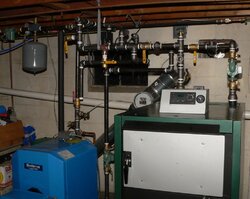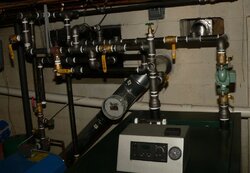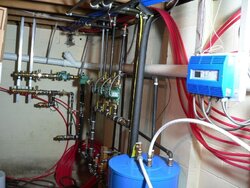With a couple days off work it seem like a good time to get serious about installing my boiler. I took advantage of Thanksgiving day guests to drop in a new flue liner and then spent quite a bit of time in the basement since. I'm waiting for a zone valve, should have been in by Friday, that I'll use for the low temp return. Other than that, I'm ready to shut down the system and tie in.
Piping progress
- Thread starter rreihart
- Start date
-
Active since 1995, Hearth.com is THE place on the internet for free information and advice about wood stoves, pellet stoves and other energy saving equipment.
We strive to provide opinions, articles, discussions and history related to Hearth Products and in a more general sense, energy issues.
We promote the EFFICIENT, RESPONSIBLE, CLEAN and SAFE use of all fuels, whether renewable or fossil.




